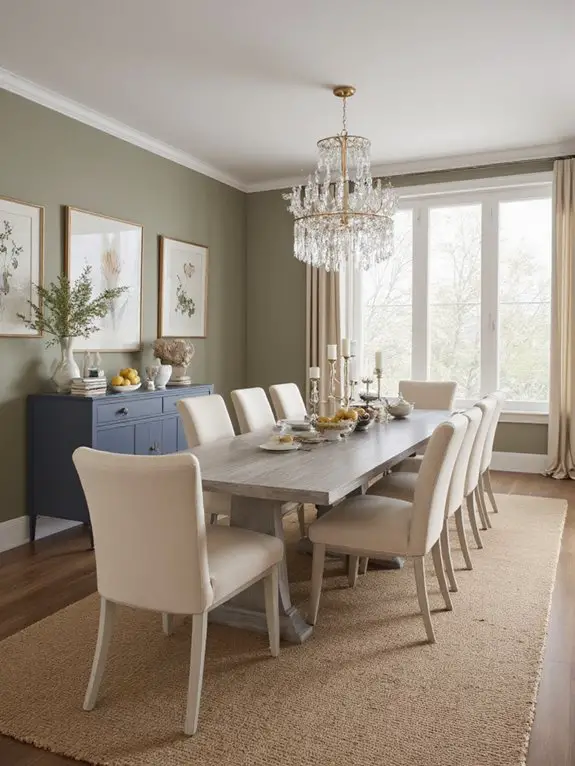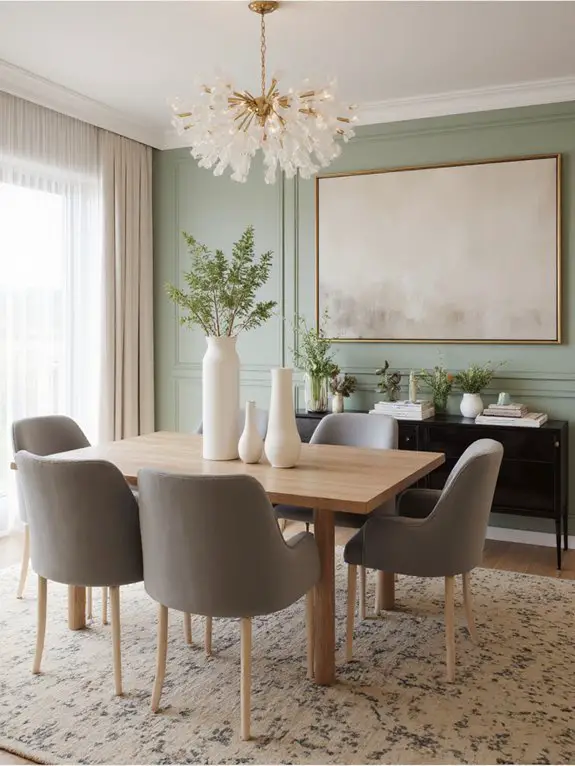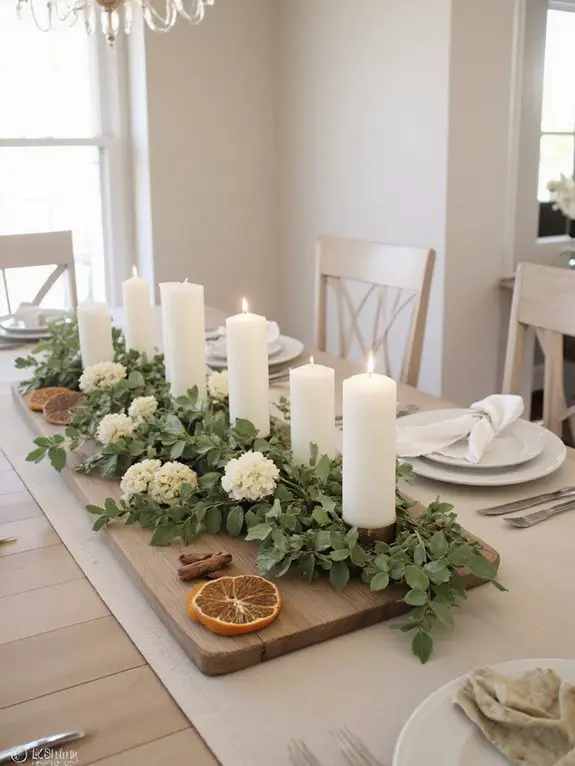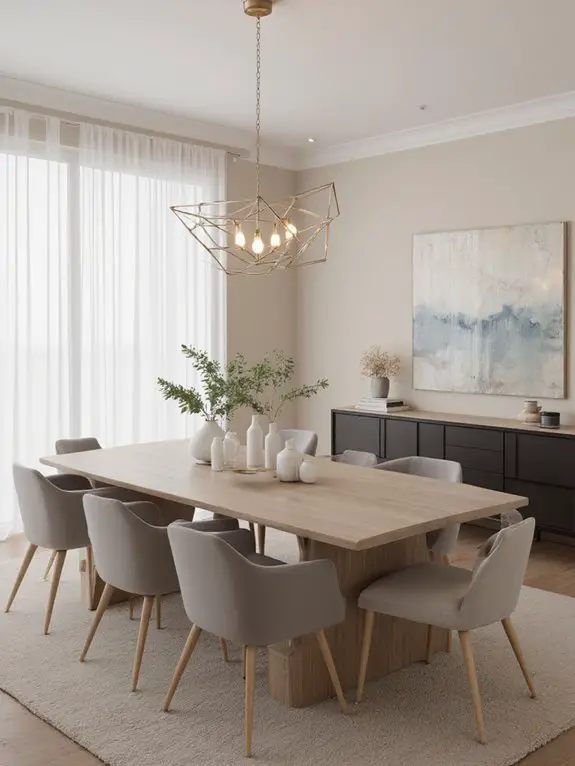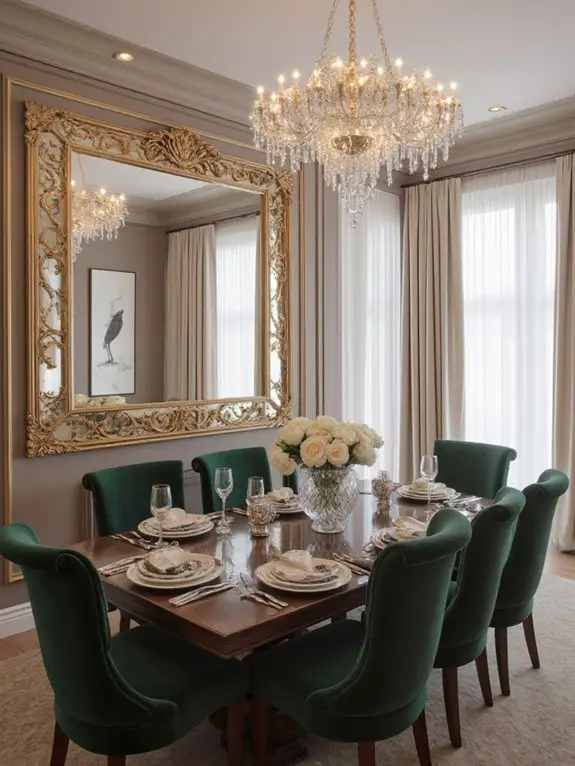I love crafting dining rooms that balance elegance and coziness by blending timeless design elements with functional touches. A rustic farmhouse charm shines with solid wood tables and mismatched chairs, while a modern minimalist retreat embraces monochromatic tones and sleek furniture. Traditional elegance calls for polished wood and crystal chandeliers, and industrial chic thrives with exposed brick and metal accents. Scandinavian simplicity focuses on light and natural textures. Discover how each style transforms your dining space.
Rustic Farmhouse Charm
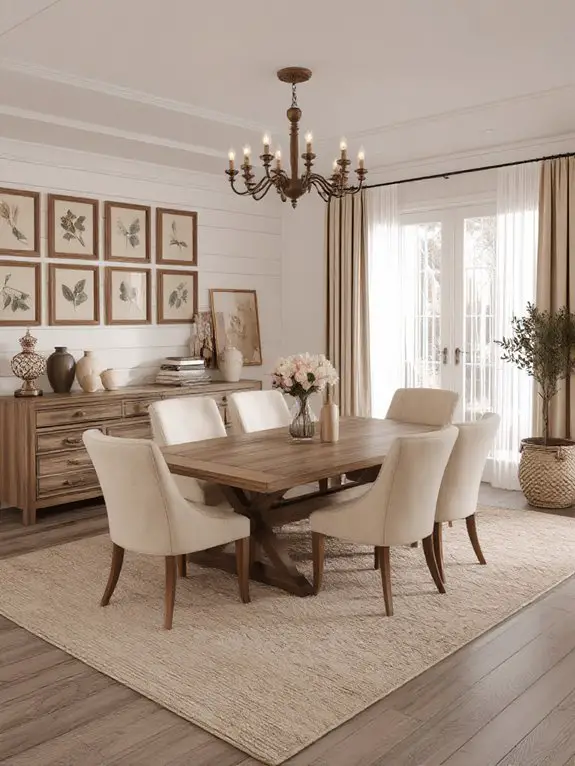
When I think of rustic farmhouse charm, I imagine warm wood tones, vintage accents, and a sense of nostalgia that makes a space feel instantly inviting. I’d start with a solid wood table, preferably reclaimed or distressed, as the centerpiece.
Pair it with mismatched wooden chairs to add character. I’d layer the table with a linen runner, mason jar centerpieces, and soft candlelight for warmth. Exposed beams or shiplap walls enhance the ambiance.
I’d incorporate woven baskets, antique china, and a weathered hutch for storage. Natural textures like jute rugs and cotton curtains complete the look, creating a cozy, timeless dining room.
Modern Minimalist Retreat
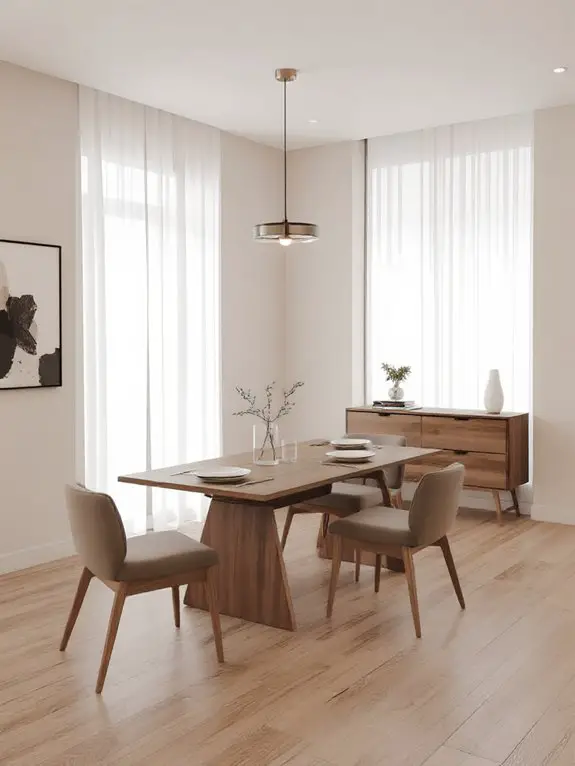
Shifting from rustic warmth to a modern minimalist retreat, I embrace clean lines, uncluttered spaces, and a palette centered on simplicity. I opt for a monochromatic color scheme, often pairing whites, grays, and blacks with subtle accents of natural wood or muted metallics.
Furniture is sleek and functional, like a streamlined dining table paired with chairs featuring geometric designs. I keep decor minimal—a single statement piece, like a sculptural pendant light, anchors the room.
Storage is discreet, hidden in built-in cabinets or understated sideboards. The result is a serene, inviting space that prioritizes calmness and intentional living.
Timeless Traditional Elegance
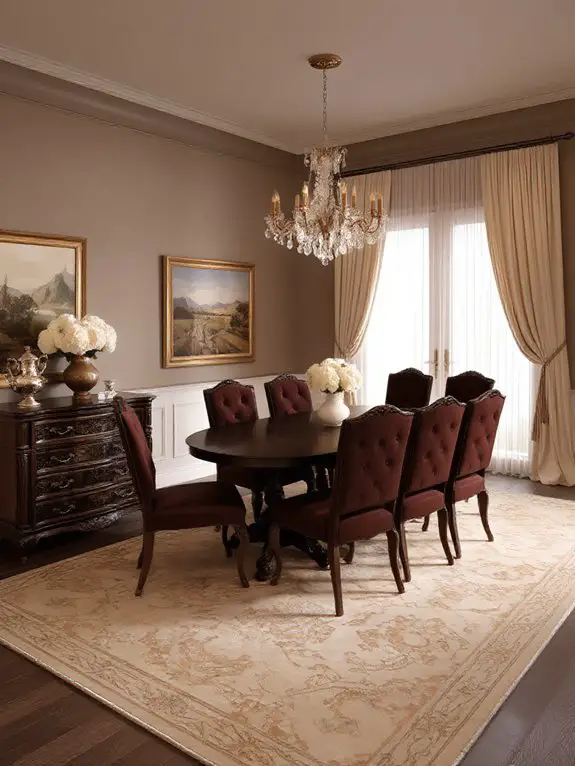
To create a dining room that exudes timeless traditional elegance, I focus on rich, classic elements that balance sophistication with comfort. I start with a polished wooden table, preferably in mahogany or cherry, paired with upholstered chairs in luxurious fabrics like velvet or damask.
Neutral tones with accents of gold, burgundy, or deep green add warmth and depth. A chandelier with crystal or bronze finishes becomes the room’s centerpiece, while wainscoting or crown molding enhances architectural detail.
I complete the look with timeless accessories like a vintage china cabinet, classic artwork, and fresh floral arrangements for a refined yet inviting atmosphere.
Industrial Chic Vibe
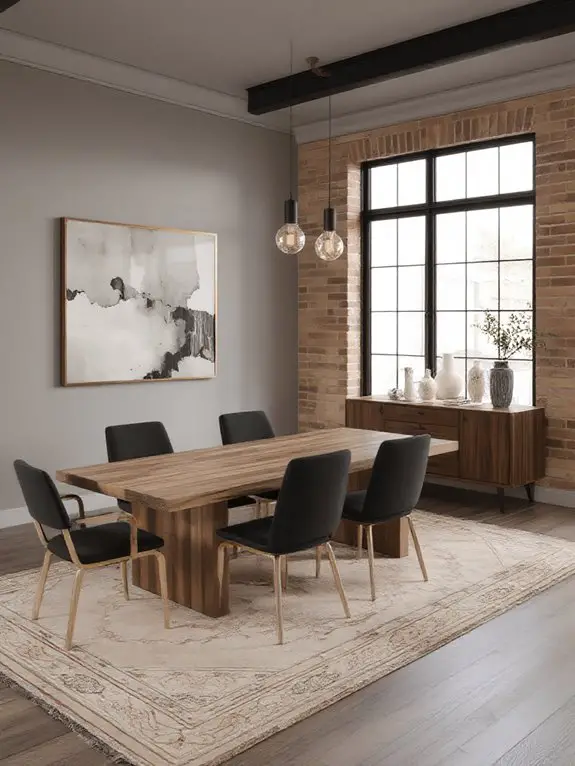
Moving from traditional elegance, I embrace the raw, edgy appeal of an industrial chic dining room. Exposed brick walls, metal accents, and reclaimed wood furniture create a balance between ruggedness and refinement.
I opt for a sturdy wooden dining table paired with sleek metal chairs or stools. Overhead, a statement pendant light with a metallic finish adds functional artistry.
Neutral tones like gray, black, and beige dominate, while pops of color come from woven rugs or abstract art. Open shelving with minimal decor keeps the space uncluttered yet personal.
This style thrives on simplicity and authenticity, blending utility with character.
Scandinavian Simplicity
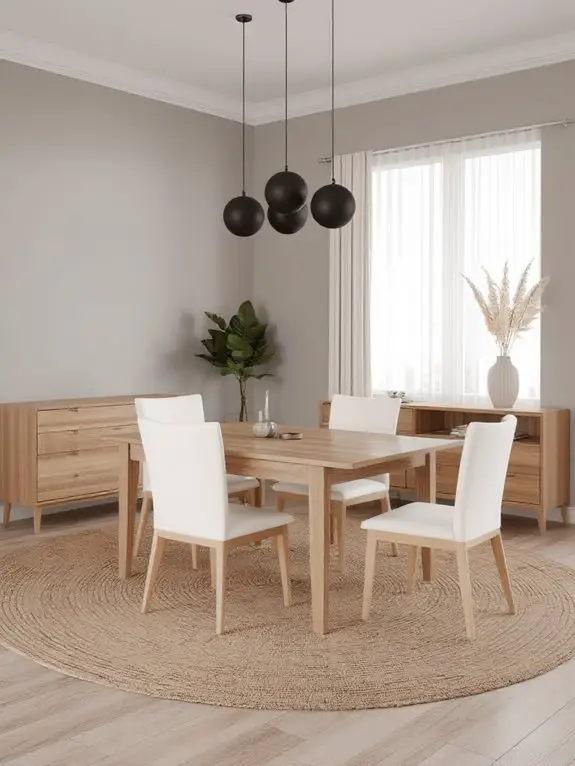
When I consider Scandinavian simplicity for my dining room, I focus on creating a space that feels light, airy, and purposeful. Minimalism is key—I stick to a neutral color palette with whites, grays, and soft wood tones to keep the room calm and inviting.
Furniture is functional yet stylish, like a sleek wooden table paired with slim, modern chairs. Natural light is emphasized, so I avoid heavy drapes and opt for sheer curtains.
Decorative elements are sparing but thoughtful—think a single vase with fresh flowers or a simple pendant light. It’s all about balance and understated elegance.
Bohemian Eclectic Style
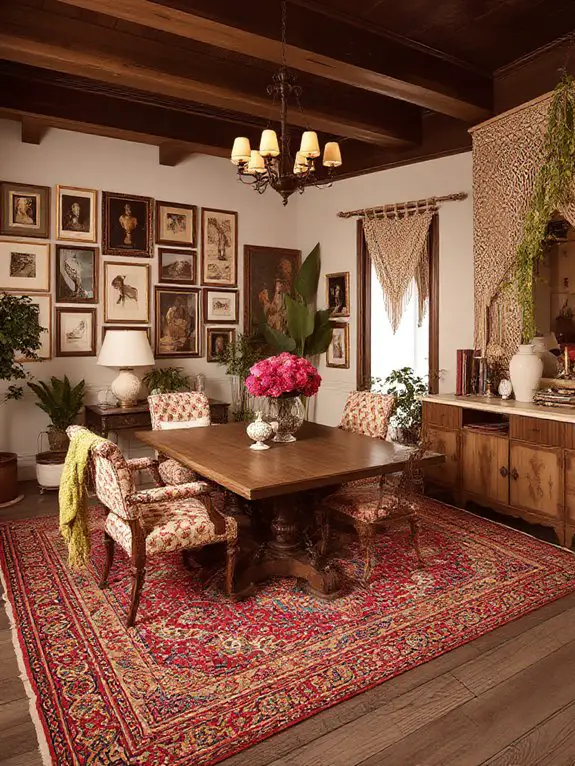
Embracing bohemian eclectic style for a dining room allows me to create a space that’s vibrant, personalized, and full of character. I love mixing bold patterns, rich textures, and eclectic furniture pieces to craft a room that feels alive.
Layering rugs, hanging tapestries, and incorporating vibrant throw pillows adds warmth and depth. I often use mismatched chairs around a rustic table to emphasize the eclectic vibe.
Plants, macramé, and vintage decor bring in a natural, artsy element. Lighting is key—I opt for Moroccan lanterns or eclectic chandeliers to enhance the ambiance.
It’s a style that invites creativity and feels uniquely personal.
Coastal Cottage Comfort
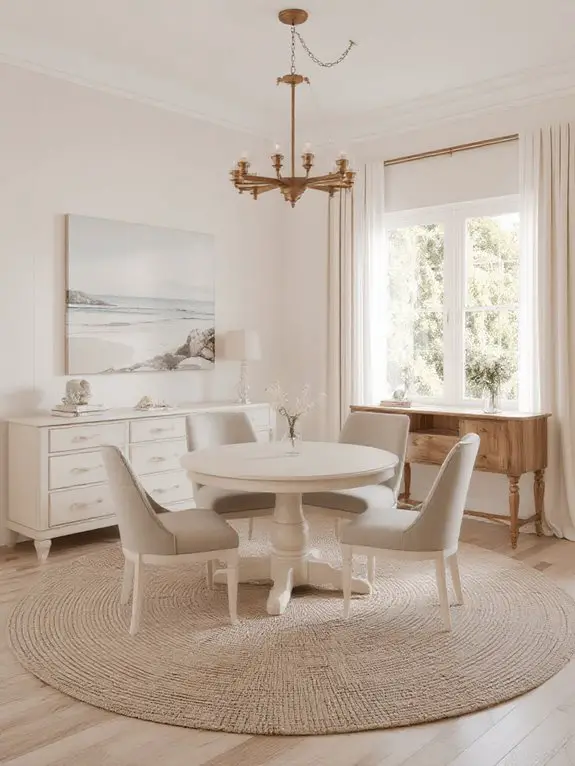
Creating a coastal cottage comfort dining room allows me to bring a relaxed, breezy atmosphere into my home, perfect for everyday meals and gatherings. I start with a light, neutral color palette—think whites, soft blues, and sandy beiges—to evoke the serene feel of the seaside. Natural materials like rattan, jute, and weathered wood add texture and warmth.
I incorporate nautical accents, such as rope details or shells, sparingly to avoid overwhelming the space. A large, airy window lets in natural light, while sheer curtains flutter gently in the breeze. The result is a space that feels both inviting and effortlessly stylish.
French Country Dining
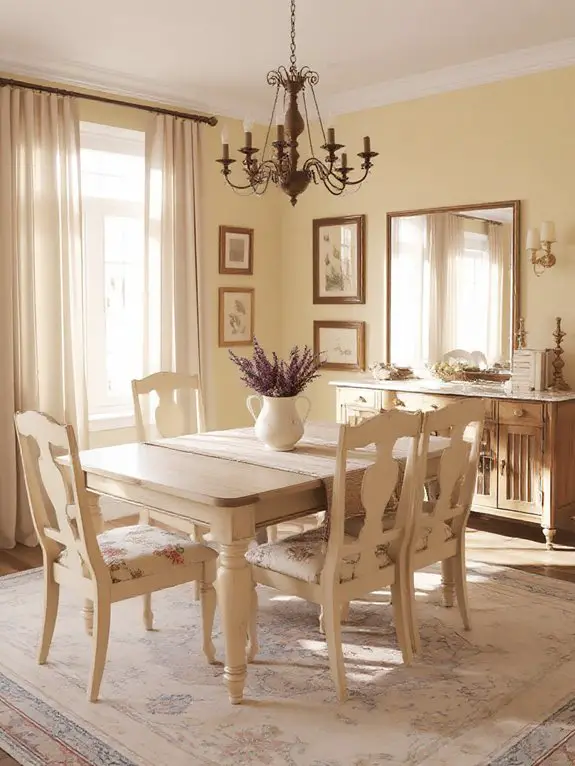
French country dining rooms effortlessly blend rustic charm with timeless elegance, and I start by choosing a warm, earthy color palette—soft creams, muted yellows, and muted greens—to create a welcoming atmosphere. I opt for sturdy wooden furniture, like a farmhouse table paired with ladder-back chairs, to anchor the space.
To soften the look, I add linen or cotton textiles, such as table runners and napkins, often in floral or gingham patterns. Antique accents, like weathered chandeliers or ceramic pitchers, bring character.
Fresh flowers or potted herbs on the table complete the scene, infusing the room with a natural, lived-in feel.
Urban Loft Coziness
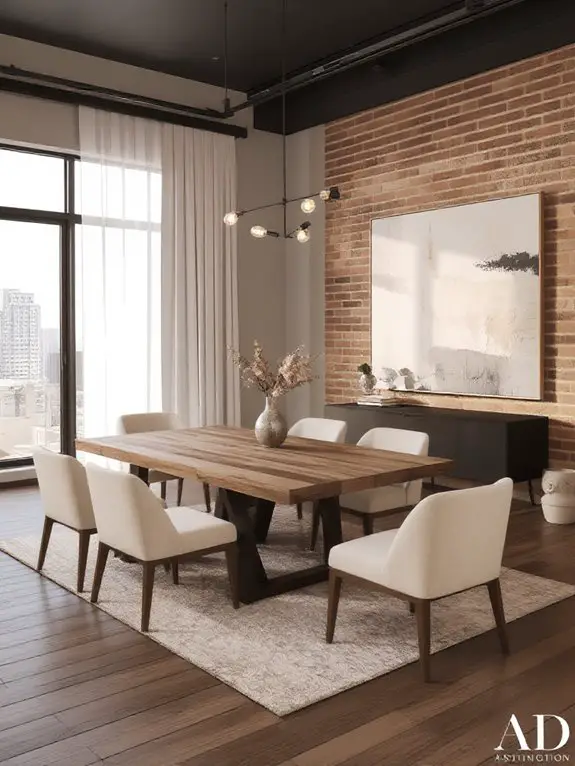
Though urban lofts often emphasize open spaces and industrial elements, it’s entirely possible to infuse them with warmth and coziness without losing their modern edge. I start by layering textures—think a plush rug under a sleek dining table or linen drapes softening exposed brick. Warm lighting, like pendant fixtures with soft Edison bulbs, adds intimacy.
I’ll introduce natural materials, such as a wooden table or woven chairs, to balance the concrete and metal.
To conclude, I bring in personal touches—a gallery wall or potted plants—to make the space feel lived-in. It’s about blending the raw with the refined to create a welcoming vibe.
Mid-Century Modern Flair
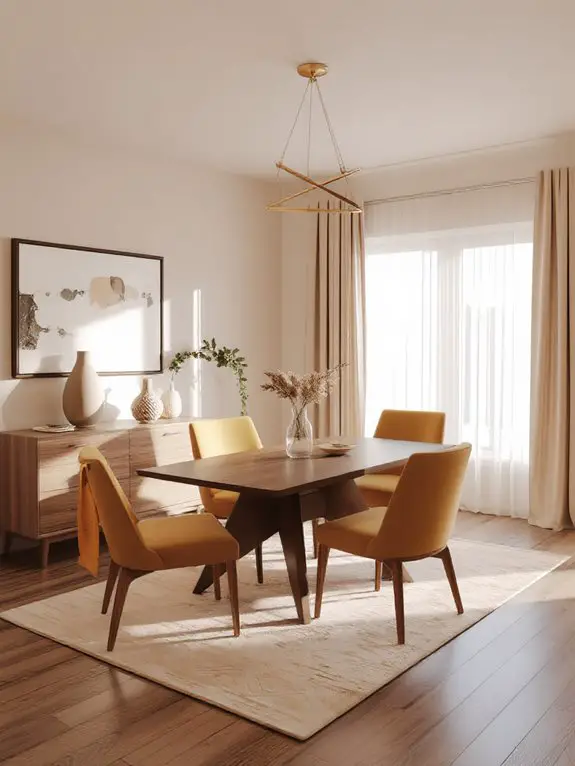
Mid-century modern flair brings a timeless yet fresh vibe to dining rooms, blending clean lines with organic warmth. I love incorporating iconic pieces like a tulip table or Eames chairs to anchor the space, ensuring functionality meets style.
Wood tones, especially teak or walnut, add natural texture, while slim, tapered legs keep the look light and airy. I suggest pairing these elements with geometric patterns or simple, bold accents for contrast.
Lighting is key—a Sputnik chandelier or a vintage-inspired pendant can elevate the room’s character. This design approach feels both nostalgic and contemporary, perfect for creating an inviting yet polished dining area.
Warm Neutral Palette
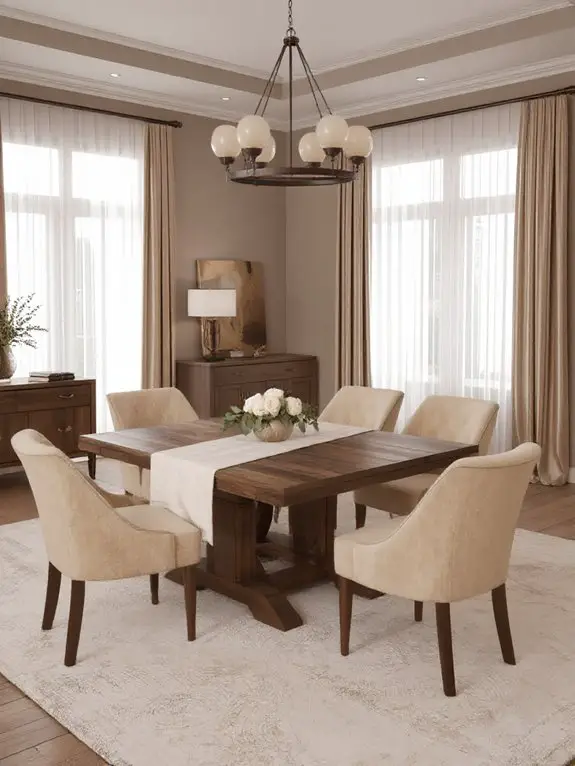
When aiming to create a dining room that feels inviting yet sophisticated, a warm neutral palette is an excellent choice. I recommend starting with shades like beige, taupe, and soft gray for walls or furniture, as they create a calm, timeless foundation.
Layering textures—think linen, wood, and woven materials—adds depth without overwhelming the space. Warm metallics, such as brass or copper, can introduce subtle elegance.
Soft lighting enhances the cozy atmosphere, so opt for warm-toned bulbs or candlelight. This palette works beautifully with a variety of styles, from rustic to modern, ensuring your dining room feels both comfortable and refined.
Bold Accent Walls
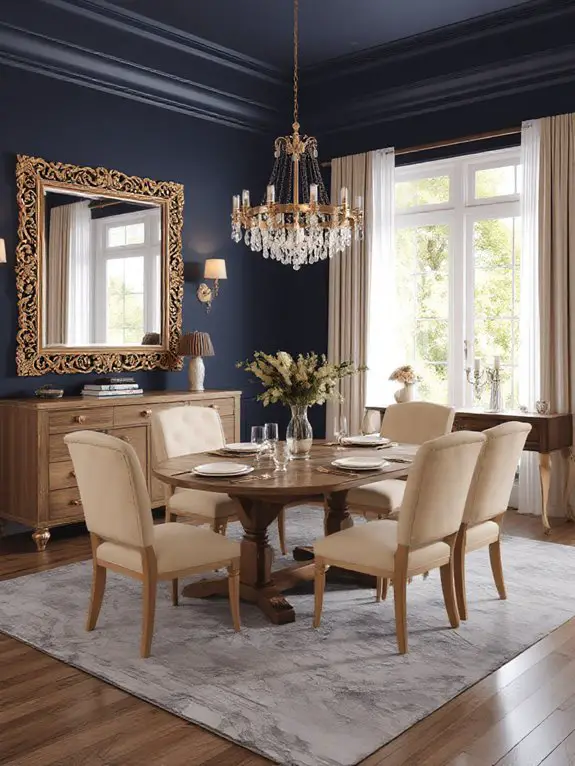
A bold accent wall can instantly transform a dining room, adding depth and personality to the space without overwhelming it. I love using rich hues like deep navy, emerald green, or even a dramatic charcoal to create a focal point that draws the eye.
When choosing a color, I consider the room’s natural light and existing decor to guarantee balance. Pairing the accent wall with neutral furnishings keeps the look cohesive while letting the wall steal the show.
For a modern twist, I sometimes incorporate textured finishes like Venetian plaster or geometric wallpaper, elevating the design without cluttering the space.
Textured Table Settings
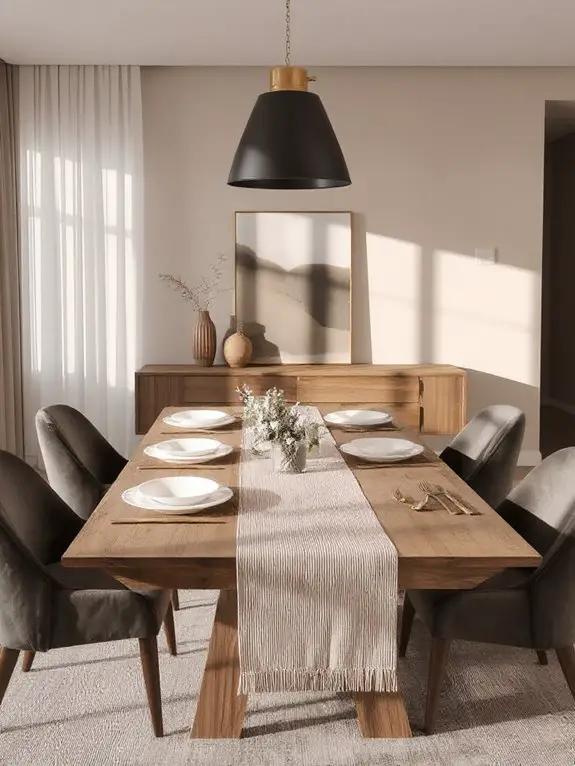
Textured table settings bring a tactile dimension to your dining room, enhancing both functionality and aesthetic appeal. I love incorporating elements like woven placemats, linen napkins, and ceramic dishes with raised patterns to create depth and interest.
Mixing materials, such as pairing smooth glassware with rough stoneware, adds contrast and warmth. Don’t shy away from layering—think burlap runners under wood chargers or lace doilies beneath rustic pottery.
These textures not only make the table visually inviting but also encourage guests to engage with their surroundings. It’s a simple yet effective way to elevate everyday meals into memorable dining experiences.
Layered Lighting Ideas
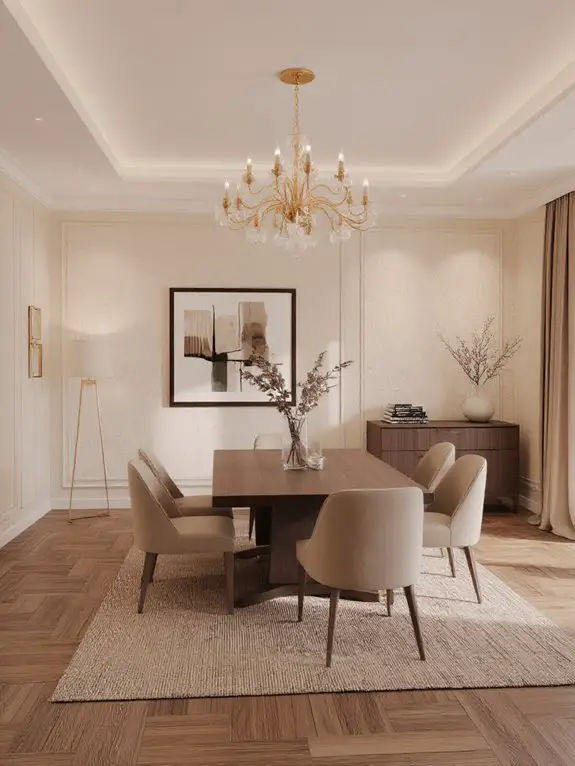
Layered lighting transforms a dining room by combining different light sources to create ambiance, functionality, and visual depth. I always start with a statement chandelier or pendant light as the focal point, ensuring it’s sized appropriately for the table.
Then, I add wall sconces or buffet lamps for softer, indirect light that enhances the mood. Dimmer switches are a must—they let me adjust the intensity to suit any occasion, from casual dinners to formal gatherings.
Finally, I incorporate candles or small table lamps for an extra layer of warmth and intimacy. The result is a space that’s both inviting and versatile.
Intimate Breakfast Nooks
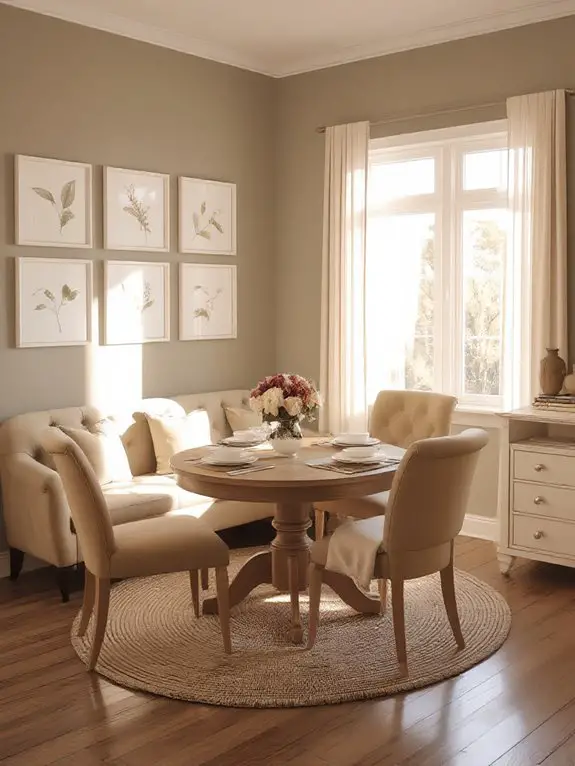
Creating an intimate breakfast nook starts with selecting the perfect spot—whether it’s a sunny corner by a window or a snug alcove tucked away from the main dining area. I recommend choosing a table that fits the scale of the space, like a round or bistro-style design, paired with comfortable seating such as bench cushions or upholstered chairs.
To enhance coziness, add soft textures like a throw pillow or a small area rug. Natural light is key, so opt for sheer curtains to let it in while maintaining privacy.
Finish with personal touches, like a small vase of fresh flowers or framed artwork, to make it feel uniquely yours.
Spacious Family-Friendly Spaces
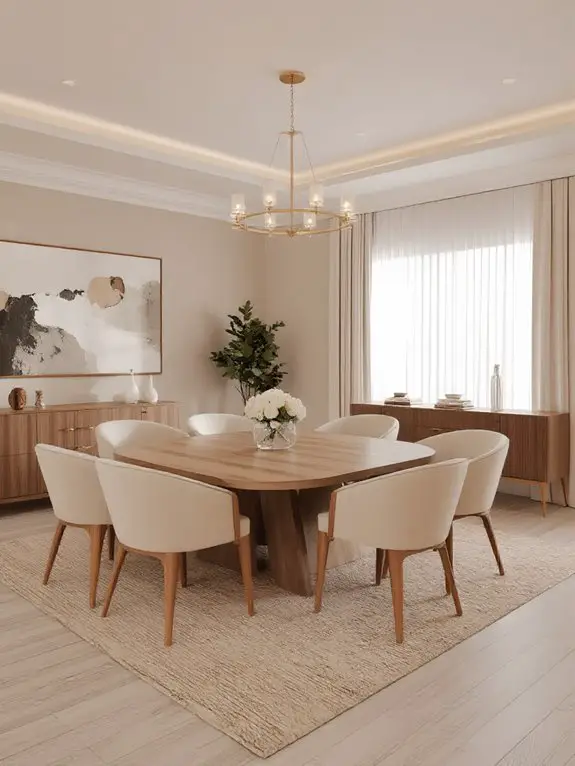
Spacious family-friendly spaces thrive on versatility and comfort, offering a welcoming environment where everyone can gather. I prioritize furniture that’s both durable and stylish, like a sturdy dining table with chairs that can withstand daily use. A bench or banquette adds flexibility, accommodating extra guests or kids.
I also incorporate storage solutions, such as a buffet or sideboard, to keep essentials within reach yet out of sight. Soft lighting, like pendant fixtures or dimmable chandeliers, creates a warm ambiance.
Rugs anchor the space while adding texture and protection. Including a mix of seating heights guarantees even the littlest ones feel included.
Open-Plan Dining Concepts
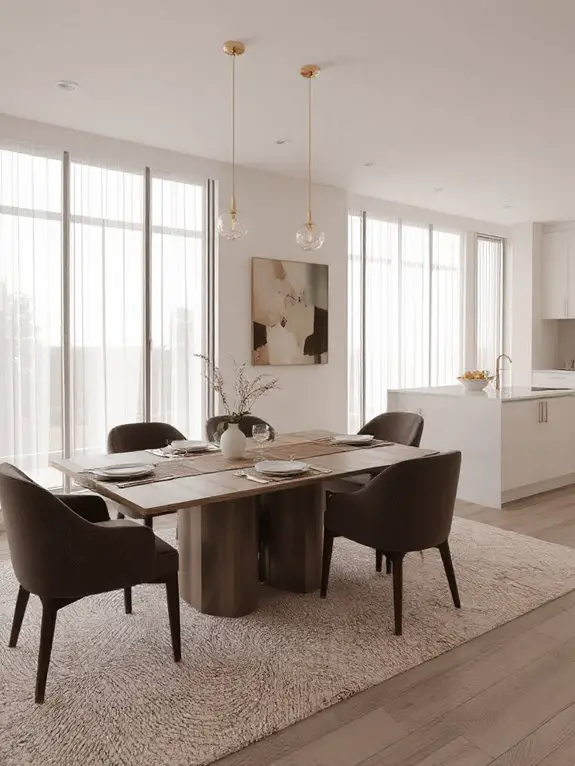
While open-plan dining concepts have become increasingly popular, they require thoughtful planning to guarantee functionality and cohesion. I always start by defining the dining zone within the larger space, using rugs, lighting, or furniture arrangements to create a sense of separation.
It’s essential to maintain visual flow, so I stick to a cohesive color palette and complementary materials throughout the area. I also consider traffic patterns to secure the dining area feels accessible without disrupting adjacent spaces.
Incorporating multifunctional furniture, like extendable tables or storage benches, helps maximize utility. By balancing openness with intentional design, I craft a dining space that’s both inviting and practical.
Tablescape Decor Tips
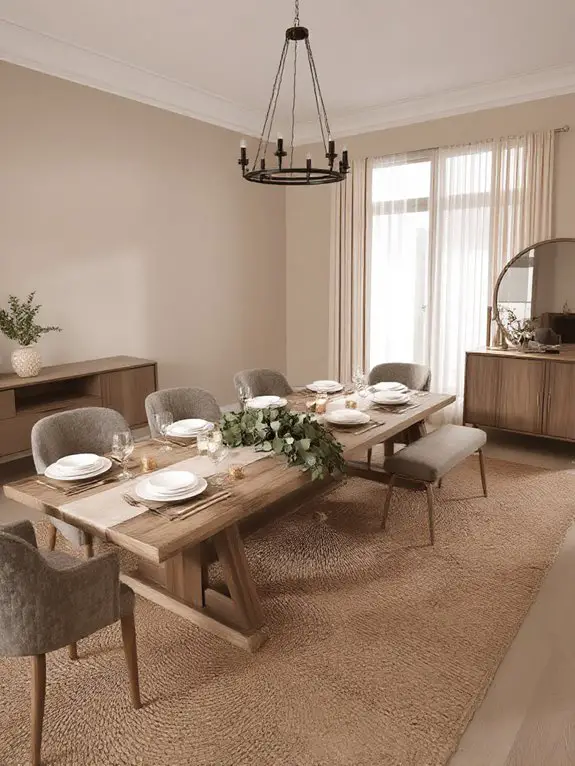
To elevate a tablescape, I focus on layering elements that combine functionality with visual appeal, starting with a foundation that sets the tone. A neutral tablecloth or runner anchors the look, while textured placemats add depth.
I incorporate natural elements like greenery or seasonal flowers for freshness and warmth. Mixing and matching dinnerware in complementary colors creates interest without overwhelming the space.
I use candles or small lanterns to add soft lighting, enhancing the cozy atmosphere. Finally, I personalize with unique napkin rings or place cards, ensuring the setup feels intentional yet inviting for every dining experience.
Cozy Bench Seating
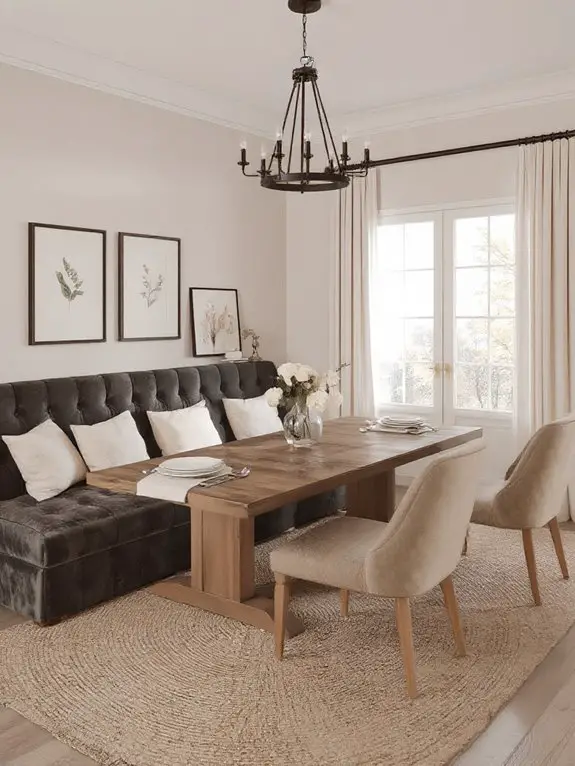
Bench seating brings a relaxed, communal feel to a dining space, making it perfect for cozy gatherings. I love how it maximizes seating without crowding the room, especially in smaller areas.
Opt for benches with padded cushions in soft, durable fabrics for comfort during long meals. Position them against a wall or under a window to save space and create a focal point.
Mix benches with chairs for versatility and visual interest. I always choose materials like wood or upholstered benches that complement my dining table and overall decor.
It’s a simple yet effective way to make my dining area feel warm and inviting.
Statement Chandeliers
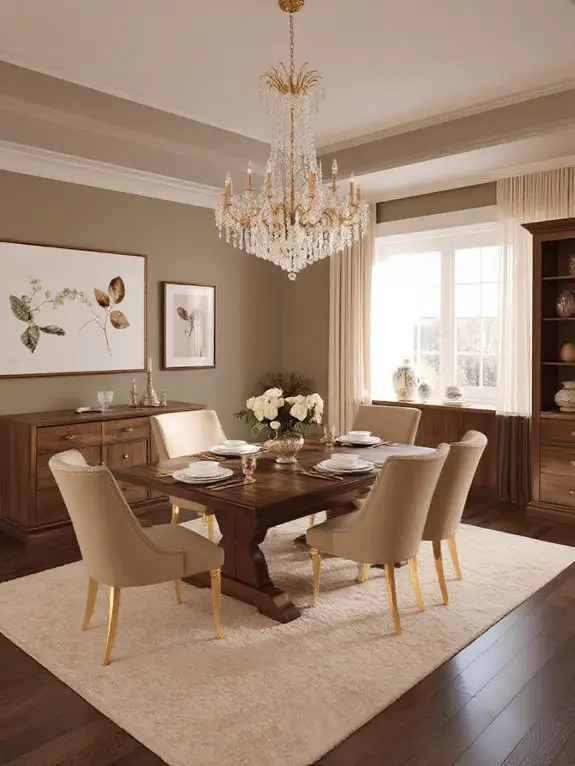
When designing a cozy dining room, a statement chandelier can instantly elevate the space, serving as both a functional light source and a striking focal point. I always recommend choosing a piece that complements the room’s proportions—too large, and it overwhelms; too small, and it feels underwhelming.
Opt for warm, dimmable lighting to create an inviting ambiance. Materials like brass, crystal, or woven rattan can add personality, whether you’re aiming for elegance or rustic charm.
Position it at the right height, typically 30-36 inches above the table, to guarantee it’s both practical and aesthetically pleasing. It’s a design investment worth making.
Mixed Material Designs
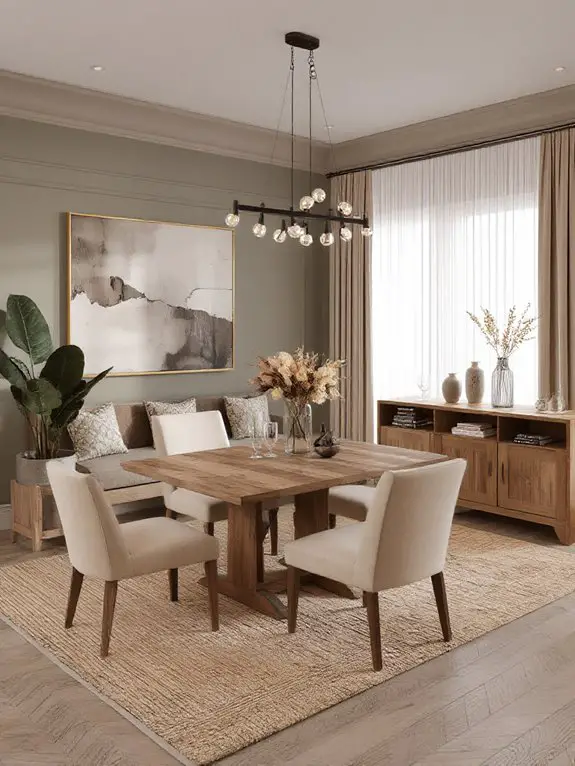
Combining different materials in a dining room design can transform the space into a dynamic yet harmonious environment. I love pairing warm wood tables with sleek metal chairs—it adds contrast without clashing.
A stone accent wall behind a rustic wooden hutch creates texture, while glass pendant lights soften the look. Don’t shy away from mixing fabrics, either; linen drapes and velvet upholstery can coexist beautifully.
Just keep a neutral base to tie everything together. The key is balance—let one material dominate while others complement. This approach elevates the room’s sophistication while keeping it inviting and cohesive.
Nature-Inspired Themes
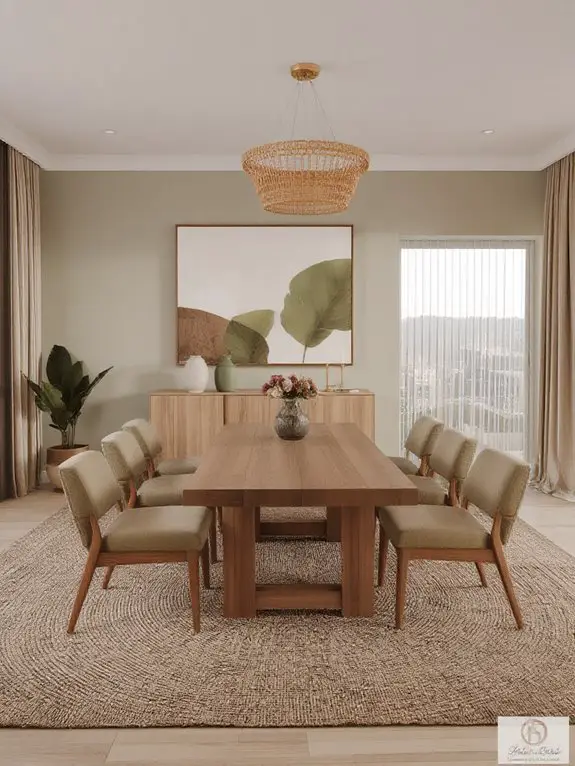
To create a dining room that feels connected to the outdoors, I always start by incorporating natural elements like wood, stone, and plants. A wooden dining table with a live-edge finish or stone accents in the flooring or walls instantly brings warmth and texture.
I love adding potted plants or hanging greenery to infuse life and freshness. Soft, earthy tones like greens, browns, and beiges further enhance the natural vibe.
For lighting, I opt for fixtures made from raw materials like rattan or bamboo. These choices create a serene, organic atmosphere that makes every meal feel like a retreat into nature.
Artisan-Touched Details
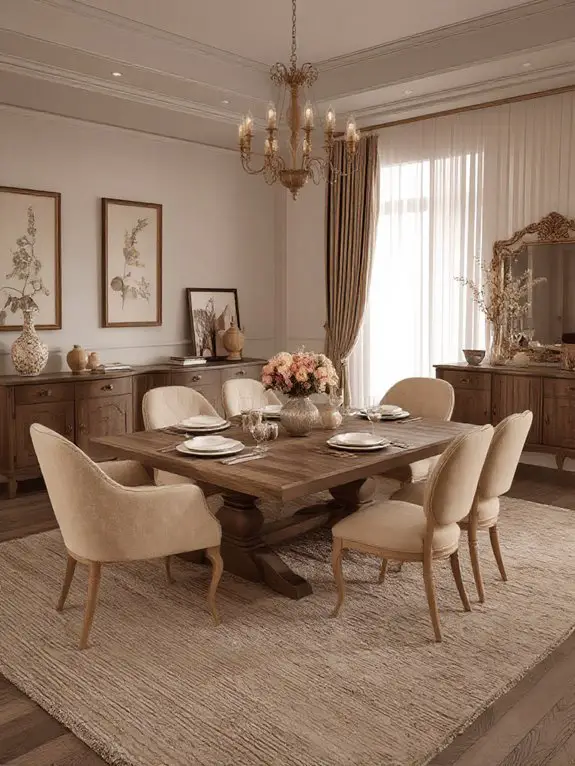
A handmade ceramic vase placed at the center of the dining table instantly adds a touch of individuality to the space. It’s a small detail that reflects craftsmanship and tells a story. I love incorporating artisanal pieces, like hand-thrown pottery or woven placemats, to create a sense of warmth and authenticity.
These elements bring character to the room and make it feel curated rather than generic. I often pair them with simple linens or neutral tableware to let their texture and design shine. Artisan details don’t need to be extravagant—they’re about celebrating the beauty of imperfection and human touch.
Warm Wood Tones
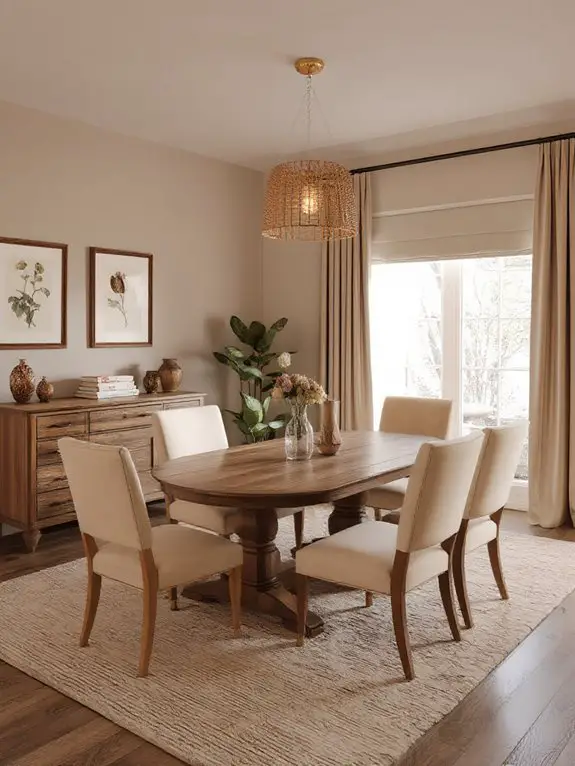
Warm wood tones can transform a dining room into an inviting haven that feels grounded and elegant. I love using rich finishes like walnut, oak, or cherry to add depth and warmth to the space.
A wooden dining table becomes the focal point, especially when paired with complementary finishes on sideboards or hutches. Don’t shy away from mixing wood tones—subtle variations can create a layered, sophisticated look.
To enhance the coziness, I recommend incorporating wooden beams or flooring for a cohesive feel. Always consider the room’s lighting; natural light amplifies the natural grain, while warm artificial light enhances the wood’s richness.
Soft Upholstered Chairs
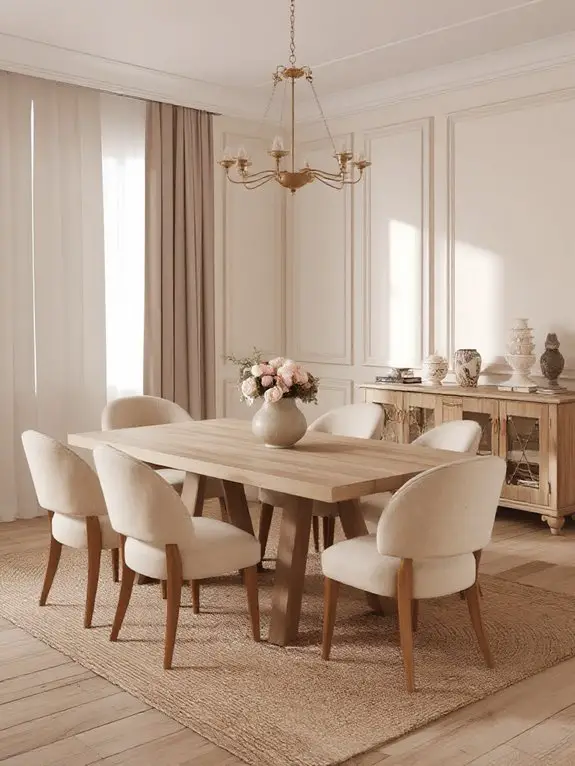
Though often overlooked, soft upholstered chairs can elevate both comfort and style in a dining room, making meals feel more inviting. I’ve found that choosing chairs with padded seats and backs adds warmth, especially during long dinners or gatherings.
Fabrics like velvet or linen not only feel luxurious but also come in a range of colors to complement your decor. I recommend opting for stain-resistant materials if you’re concerned about spills.
Additionally, ergonomic designs guarantee guests stay comfortable, while tufted details or button accents can introduce a touch of elegance. They’re a small change that makes a big impact.
Vintage-Inspired Decor
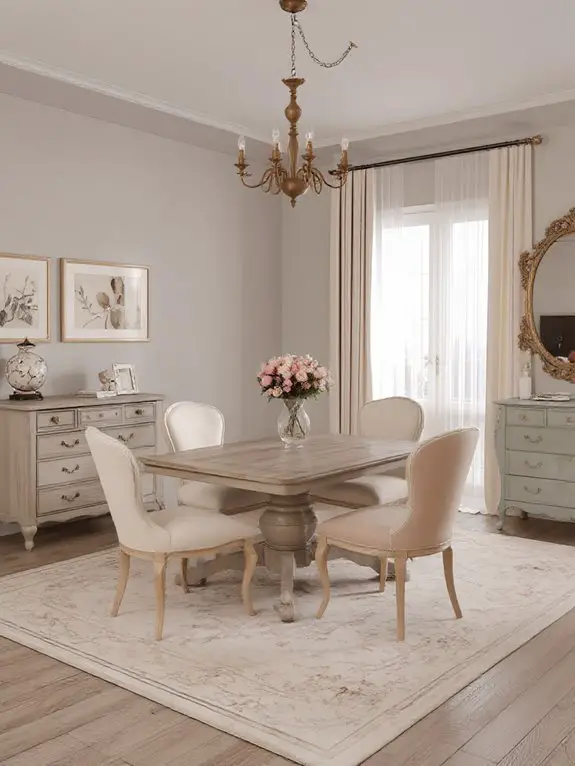
When incorporating vintage-inspired decor into a dining room, I’ve discovered it’s essential to balance authenticity with functionality. Start with a statement piece, like a reclaimed wood table or a chandelier with antique brass details.
Pair it with chairs that blend period charm and modern comfort. I often use mismatched china or heirloom silverware to add character without overwhelming the space.
Soft, patterned textiles in muted tones can evoke nostalgia while keeping the room inviting. Don’t shy away from distressed finishes or patina—they add depth.
Finally, incorporate subtle touches, like framed vintage posters or lace table runners, to complete the look with understated elegance.
Monochromatic Color Schemes
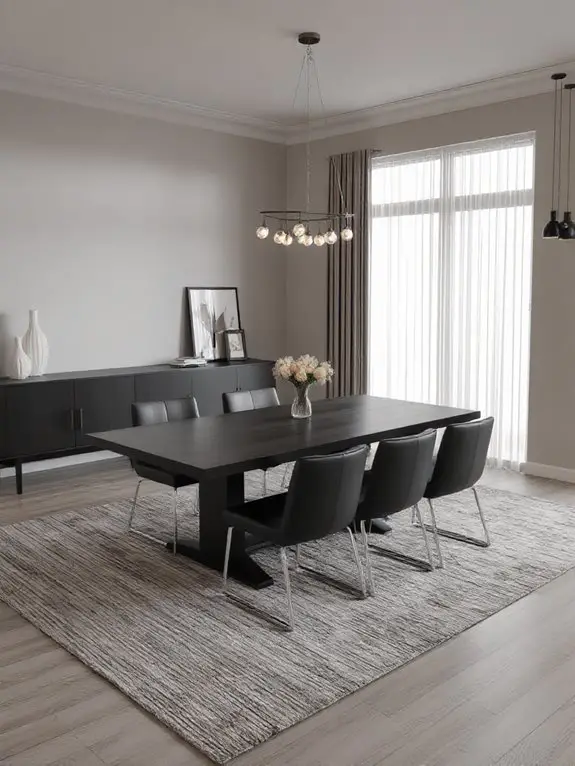
While designing a dining room, opting for a monochromatic color scheme can create a striking, cohesive aesthetic that feels both modern and timeless. I often recommend focusing on a single hue, like soft gray, deep navy, or warm beige, and layering its shades and tones throughout the space.
This approach adds depth without overwhelming the eye. For instance, I might pair lighter walls with darker furniture and textured accents in the same color family to maintain harmony.
Adding metallic finishes or natural wood elements can enhance the scheme while keeping it grounded. It’s a simple yet elegant way to achieve sophistication.
Built-In Banquette Seating
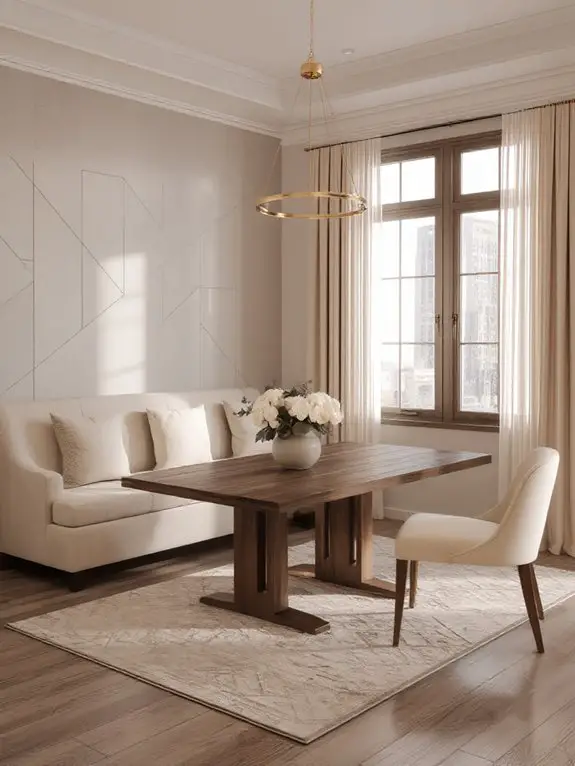
Built-in banquette seating can transform a dining room into a functional and inviting space, maximizing both style and practicality. I love how it tucks neatly against walls or corners, saving floor space while offering ample seating.
Customizing the cushions and upholstery lets me match my room’s aesthetic, whether it’s sleek modern or rustic charm. Storage drawers or cabinets beneath the bench add functionality, perfect for stashing linens or tableware.
It’s also a clever way to make the dining area feel cozier, encouraging intimate gatherings. With the right design, a banquette becomes a focal point that blends comfort and elegance seamlessly.
Oversized Statement Rugs
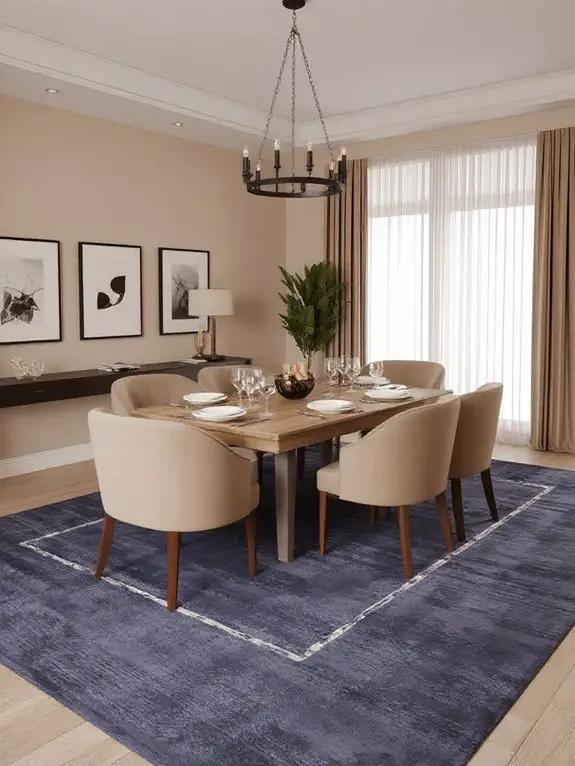
To anchor a dining room with warmth and visual impact, an oversized statement rug can define the space while tying together furniture and decor. I recommend choosing a rug that extends at least 24 inches beyond the table on all sides, ensuring chairs remain on it even when pulled out.
Opt for durable materials like wool or polypropylene to withstand spills and heavy use. Patterns or colors should complement your dining set and walls, adding depth without overwhelming the room.
A rug with a low pile is practical for easy cleaning, while a bold design can serve as a striking focal point.
Window Seat Dining Ideas
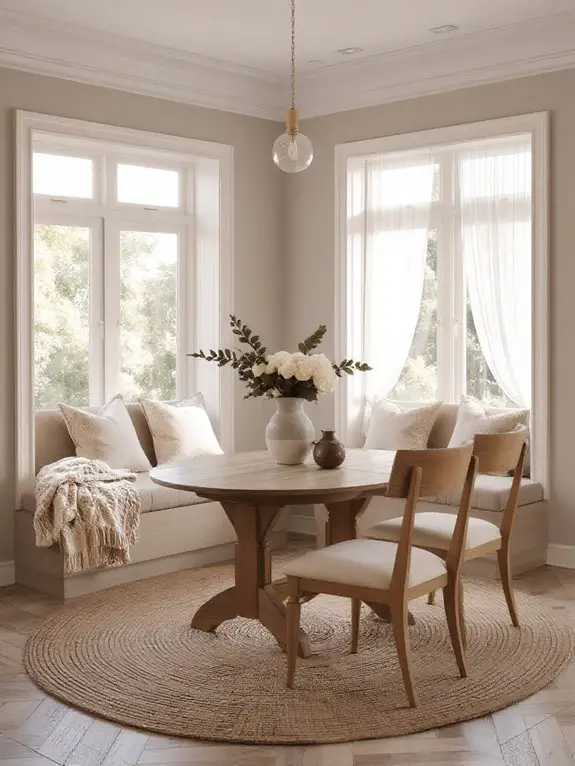
If you’re looking to maximize both seating and charm in your dining area, a window seat can transform an underutilized nook into a cozy, functional spot. Start by measuring the space to guarantee the seat fits comfortably while leaving enough room for dining chairs.
Opt for a built-in bench with storage underneath for practicality, or use a standalone bench for flexibility. Add plush cushions and throw pillows in coordinating colors to create a welcoming vibe.
Position the seat near a table to encourage casual meals or afternoon tea. Layer in soft lighting and greenery to enhance the serene, intimate atmosphere.
Frequently Asked Questions
How to Maximize Storage in a Small Dining Room?
When I need more storage in my small dining room, I use multi-functional furniture like benches with hidden compartments, wall shelves, or a sideboard. I also declutter often and prioritize vertical space to keep it organized.
What Flooring Works Best for a Cozy Dining Room?
I just stumbled upon warm hardwood floors that feel like a hug underfoot—perfect for cozy dining. If I want extra softness, I’d layer a rug, but hardwood’s timeless charm makes every meal feel inviting.
How to Blend Dining Room Design With Adjacent Spaces?
I’d focus on matching colors, textures, or materials to create flow between spaces. I’d use open shelving or rugs to define areas subtly. Coordinating lighting styles helps tie rooms together without losing their individual charm.
Are There Pet-Friendly Dining Room Design Options?
I’d choose durable, stain-resistant fabrics for chairs and avoid sharp edges on furniture. I’d also keep decor minimal to prevent knocking things over and consider a washable rug for easy cleanup. Pets’ safety and comfort matter.
How to Maintain Cleanliness in a Cozy Dining Room?
Studies show 70% of spills happen in dining areas. I wipe surfaces daily, use washable fabrics, and clean spills immediately to prevent stains. I also vacuum or sweep after meals to keep my cozy dining room spotless.

